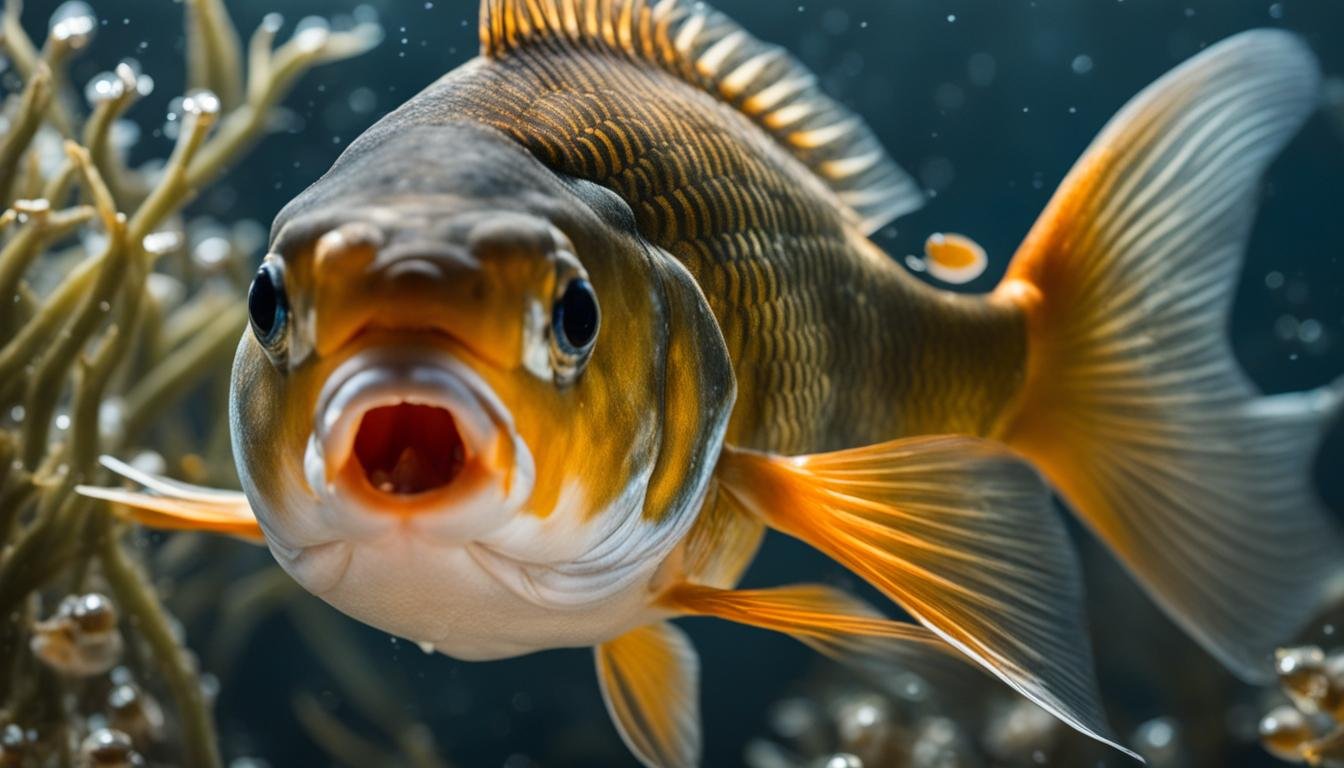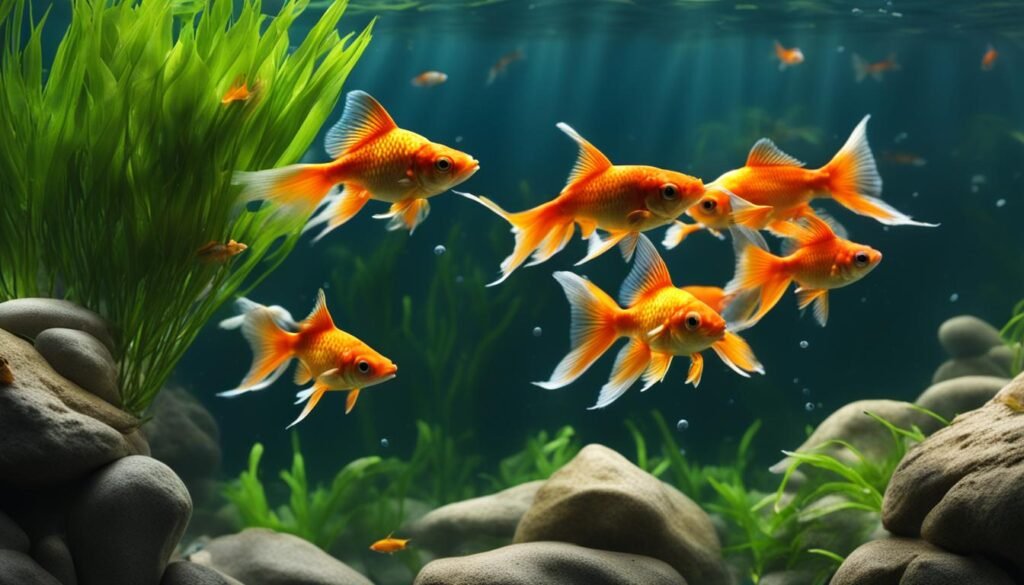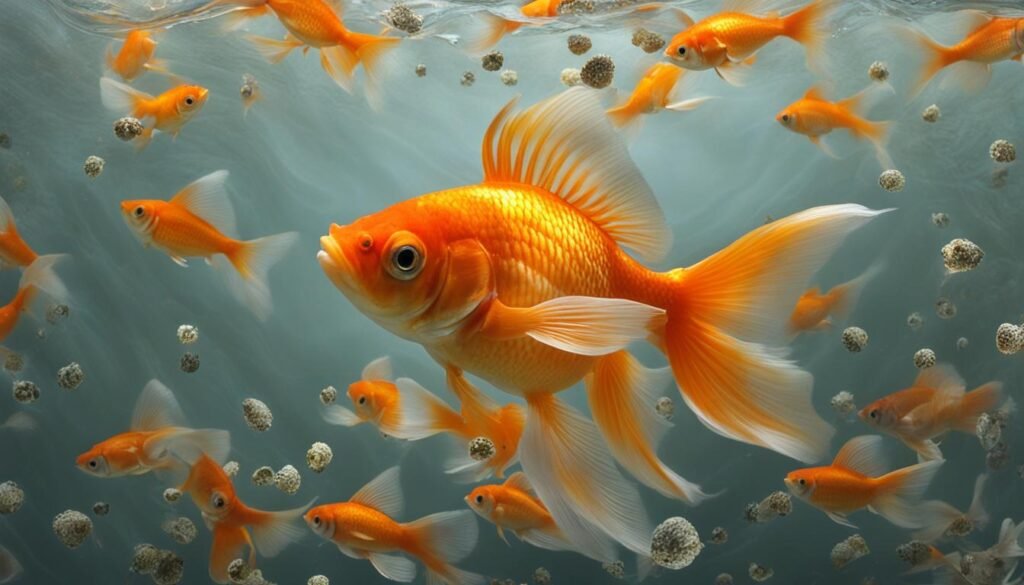Your cart is currently empty!

Do Goldfish Eat Minnows? Unveiling the Aquatic Diet Mysteries.
Are you curious about the dietary habits of goldfish? Specifically, whether these fascinating aquatic creatures indulge in a meal of minnows? Let’s explore the intriguing world of goldfish feeding habits and uncover the truth behind this aquatic diet mystery.
Goldfish, as it turns out, have a diverse palate. They are omnivorous animals that consume both plant and animal matter. While goldfish are not natural predators and do not actively hunt other fish, it is possible for them to nibble or scavenge anything that fits into their mouth, including minnows.
However, the likelihood of goldfish eating minnows depends on several factors. These include the size of the goldfish, the size and type of the minnows, the hunger and temperament of the goldfish, and the behavior of the minnows themselves. Considering these factors is crucial when deciding whether to keep goldfish and minnows together in a shared tank.
Key Takeaways:
- Goldfish are omnivorous creatures that consume both plant and animal matter.
- While goldfish are not natural predators, they may nibble on minnows if they fit into their mouths.
- The likelihood of goldfish eating minnows depends on factors such as size, hunger, temperament, and compatibility.
- Understanding the natural behavior and diet of goldfish is important when considering tank mates.
- Consider providing enough space and hiding places for both goldfish and minnows to reduce stress and aggression.
Understanding Goldfish Behavior and Diet
When it comes to understanding goldfish behavior and diet, it’s important to recognize that these aquatic creatures are naturally inclined to consume a variety of food sources. Goldfish are classified as omnivores, meaning they have the capability to eat both plant and animal matter. In their natural habitat, goldfish typically feed on aquatic plants, algae, insects, worms, crustaceans, and even small fish.
While goldfish are not aggressive predators, they may exhibit predatory tendencies in certain circumstances. This means that under specific conditions, goldfish may engage in behaviors such as hunting and consuming small fish, including minnows. However, it’s crucial to note that not all goldfish will display this behavior, and it may vary depending on factors such as the size of the goldfish, the size and type of the minnows, the hunger and temperament of the goldfish, and the behavior of the minnows themselves.
Understanding the natural behavior and diet of goldfish is essential when considering whether to introduce them to a tank with minnows or other small fish. By taking these factors into account, you can make informed decisions about the compatibility and cohabitation of different species in your aquarium. It’s always crucial to provide a suitable environment and appropriate nutrition for all the inhabitants of your tank, ensuring their health and well-being.
Key Points:
- Goldfish are naturally inclined to eat a variety of food sources, including plants and small animals.
- While goldfish are not aggressive predators, they may exhibit predatory tendencies in certain circumstances.
- The compatibility between goldfish and minnows depends on factors such as size, hunger, temperament, and the behavior of the minnows.
- Understanding the natural behavior and diet of goldfish is crucial when considering tank cohabitation.
Factors Affecting Goldfish and Minnow Compatibility

When considering keeping goldfish and minnows together in a tank, it’s important to understand the factors that can affect their compatibility. Several key elements come into play, including the size and type of the fish, as well as the hunger and temperament of the goldfish, and the behavior of the minnows. By considering these factors, you can make an informed decision about whether or not to keep goldfish and minnows together.
1. Fish Size
The size of the goldfish is an important consideration when determining whether they can coexist with minnows. Larger goldfish may pose a risk to smaller minnows, as they have the potential to swallow or injure them. If you have larger goldfish, it may be best to avoid adding minnows to the tank to ensure the safety of the smaller fish.
2. Fish Type
Not all fish have the same diet and behavior. Different species of goldfish and minnows may have different preferences when it comes to food and social dynamics. It’s important to research the specific species of goldfish and minnows you intend to keep together to determine if they are compatible. Some breeds of goldfish are known to be more prone to aggressive behavior, which could lead to conflicts with minnows.
3. Hunger and Temperament of Goldfish
The hunger and temperament of your goldfish can also impact their compatibility with minnows. Hungry or aggressive goldfish are more likely to eat other fish, including minnows. It’s crucial to ensure that your goldfish are adequately fed and their hunger is satisfied to reduce the chances of them preying on the minnows. Additionally, observing the temperament of your goldfish is essential, as overly aggressive or territorial behavior can pose a threat to the minnows.
4. Behavior of Minnows
The behavior of the minnows themselves can also affect their compatibility with goldfish. Minnows that provoke or annoy the goldfish may be more likely to be targeted for aggression. It’s important to monitor the interactions between the goldfish and minnows and ensure that the minnows are not causing excessive stress or aggression in the tank. By understanding the behavior of both the goldfish and minnows, you can better assess their compatibility.
Tips for Keeping Goldfish and Minnows Together
https://www.youtube.com/watch?v=je6fVXfeOIQ
If you’re considering keeping goldfish and minnows together in a tank, there are several important factors to consider. By following these tips, you can ensure the compatibility of both species and create a harmonious aquatic environment.
1. Choose Compatible Tank Mates
When selecting tank mates for your goldfish and minnows, it’s important to choose species that are compatible. Some suitable tank mates for goldfish and minnows include rosy barbs, zebra danios, or white cloud mountain minnows. These fish are generally peaceful and can coexist well with both goldfish and minnows.
2. Provide Enough Space and Hiding Places
Creating a spacious and well-equipped tank is crucial for the well-being of both goldfish and minnows. Make sure the tank is large enough to accommodate all the fish comfortably. Additionally, provide plenty of hiding places such as rocks, plants, or caves, as these will help reduce stress and aggression among the fish.
3. Feed Goldfish Adequately
Proper nutrition is essential for the health of your goldfish and minnows. Goldfish are omnivorous and require a balanced diet consisting of both plant and animal matter. Feed them a high-quality commercial fish food that is specifically formulated for goldfish. Avoid overfeeding, as this can lead to obesity and other health issues.
4. Monitor Fish Behavior and Health
Regularly observe the behavior and health of your goldfish and minnows to ensure they are thriving. Look out for any signs of stress, illness, or aggression. If you notice any unusual behavior or symptoms, take appropriate action promptly.
By following these tips, you can increase the chances of successfully keeping goldfish and minnows together in a tank. Remember to always prioritize the well-being of your fish and provide them with a suitable and enriching environment.
The Clove Oil Method of Euthanizing Fish

When it comes to euthanizing fish in a humane way, the clove oil bath method is considered one of the most effective and compassionate options. Clove oil acts as an anesthetic, gently putting the fish to sleep before it passes away without experiencing any pain or distress. This method is recommended by the American Veterinary Medical Association and is widely used by fish owners and enthusiasts.
To perform the clove oil bath, start by catching the fish and placing it in a container filled with water from the aquarium. In a separate container, create a solution of clove oil and water. Slowly add the clove oil solution to the container with the fish, ensuring that it is mixed well. The fish will gradually become unconscious and peacefully pass away.
Steps to Perform the Clove Oil Bath Euthanasia Method:
- Catch the fish and place it in a container with aquarium water.
- Mix a solution of clove oil and water in a separate container.
- Slowly add the clove oil solution to the container with the fish, stirring gently.
- Observe the fish as it becomes unconscious and peacefully passes away.
It is important to note that performing euthanasia on a fish should be done with care and consideration. The clove oil bath method provides a humane way to end the suffering of a sick or injured fish, ensuring that it is done with the utmost compassion.
The Stun and Stab Method of Euthanizing Fish

When it comes to euthanizing fish quickly and humanely, the stun and stab method is a commonly used technique. This method involves two steps: first, stunning the fish to render it unconscious, and then delivering a swift and precise stab to ensure a quick death. It is important to note that this method should only be attempted by individuals who are comfortable with the process, as it can be graphic.
The first step of the stun and stab method is to stun the fish. This is typically done by gently hitting the fish on the head with a blunt object, such as a heavy spoon or a wooden mallet. The goal is to render the fish unconscious quickly and efficiently. It is essential to work quickly and accurately to minimize any unnecessary suffering.
Once the fish is stunned and unconscious, the second step is to deliver a swift and precise stab to the fish’s brain, ensuring a quick death. This can be achieved by using a sharp object, such as a knife or a specialized fish euthanasia tool. It is crucial to aim for the fish’s brain to ensure a swift and painless death. Aluminum foil can be used to contain the fish and prevent blood from splattering during the process.
Benefits of the Stun and Stab Method:
- Quick and efficient method of euthanasia
- Ensures a fast and painless death for the fish
- Requires minimal equipment and resources
- Can be performed by individuals who are comfortable with the process
It is important to approach the stun and stab method with the utmost care and consideration for the well-being of the fish. Proper training and understanding of the technique are essential to ensure a humane euthanasia process. If you are uncertain or uncomfortable with performing the stun and stab method, it is recommended to seek guidance from a professional or veterinarian.
Exploring the Theory of Fish Dispersal by Water Birds

The theory of fish dispersal by water birds has long fascinated scientists and naturalists alike. According to this theory, fish eggs may adhere to the feathers or feet of water birds, enabling these avian creatures to transport the eggs to new bodies of water where they eventually hatch. One of the earliest proponents of this idea was Charles Darwin, who proposed it in the 19th century.
While the theory of fish dispersal by water birds has gained widespread acceptance, a recent systematic literature review conducted by researchers at the University of Basel has cast doubt on its validity. Despite its long-standing belief, the review found no empirical evidence to support the theory. This raises the need for further studies to ascertain the role of water birds in fish dispersal.
We recognize the importance of understanding how fish are dispersed, as it has implications for maintaining biodiversity and managing invasive species. While the theory of fish dispersal by water birds may need further verification, it still offers intriguing insights into the complex interactions between aquatic organisms.
The Role of Charles Darwin
Charles Darwin, renowned for his contributions to the theory of evolution, also had a keen interest in fish dispersal. He was among the first to propose the idea that water birds could aid in the dispersal of fish eggs. Darwin observed that water birds often travel long distances and speculated that they could inadvertently carry fish eggs from one body of water to another, thereby contributing to the colonization of new habitats by fish species.
While the exact mechanisms of fish egg adhesion to water birds and subsequent survival remain unclear, Darwin’s early insights have paved the way for further exploration of this fascinating phenomenon. It is a testament to Darwin’s curiosity and scientific acumen that his ideas continue to inspire and shape our understanding of fish dispersal.
Conclusion
In conclusion, when it comes to goldfish eating minnows, there are several factors to consider. Size, hunger, temperament, and compatibility all play a role in whether or not goldfish will consume minnows. While goldfish are not natural predators, they may scavenge or nibble on anything that fits in their mouth, including minnows. Therefore, it is important to carefully assess the dynamics of your tank before introducing goldfish and minnows together.
Understanding the natural behavior and diet of goldfish is crucial in making an informed decision. Goldfish are omnivorous, meaning they eat both plant and animal matter. They have a diverse diet that includes aquatic plants, algae, insects, worms, crustaceans, and yes, even small fish like minnows. However, this does not mean all goldfish will eat minnows, as it depends on various factors previously discussed.
When it comes to euthanizing fish, there are humane methods available. The clove oil bath is recommended by the American Veterinary Medical Association as a way to euthanize fish without causing unnecessary suffering. Another method is the stun and stab approach, but it should only be attempted by those comfortable with the process and performed with care.
While the theory of fish dispersal by water birds is widely believed, there is a lack of empirical evidence to support it. Further studies are needed to validate the role of water birds in fish dispersal. Understanding how fish are dispersed is crucial for managing invasive species and maintaining biodiversity in our aquatic ecosystems.
FAQ
Do goldfish eat minnows?
Whether goldfish eat minnows depends on factors such as the size of the goldfish, the size and type of the minnows, the hunger and temperament of the goldfish, and the behavior of the minnows. It is important to consider these factors when deciding whether to keep goldfish and minnows together in a tank.
What do goldfish eat?
Goldfish are omnivorous animals that eat both plant and animal matter. Their diet may include aquatic plants, algae, insects, worms, crustaceans, and small fish.
How can I keep goldfish and minnows together in a tank?
To ensure compatibility between goldfish and minnows, choose compatible tank mates such as rosy barbs, zebra danios, or white cloud mountain minnows. Provide enough space and hiding places for both fish to reduce stress and aggression. Feed your goldfish adequately and regularly to prevent them from eating minnows out of hunger. Monitor the behavior and health of both fish and separate any breeding pairs and fry to prevent the goldfish from eating them.
What is the clove oil method of euthanizing fish?
The clove oil method is a humane way to euthanize fish. It involves placing the fish in a container with water from the aquarium and mixing clove oil with water in a separate container. The clove oil is then added slowly to the container with the fish, causing it to become unconscious and eventually pass away.
What is the stun and stab method of euthanizing fish?
The stun and stab method is a quick method of euthanizing fish. It involves hitting the fish with a blunt object to knock it unconscious and then stabbing it in the brain to ensure a quick death. This method should only be attempted by those comfortable with the process and should be done quickly and accurately to ensure a humane death for the fish.
Do water birds disperse fish eggs?
The theory of fish dispersal by water birds suggests that fish eggs stick to the feathers or feet of water birds, allowing the birds to transport the eggs to new bodies of water where they hatch. However, a systematic literature review found no evidence to support this theory. Further studies are needed to validate the role of water birds in fish dispersal.
Leave a Reply